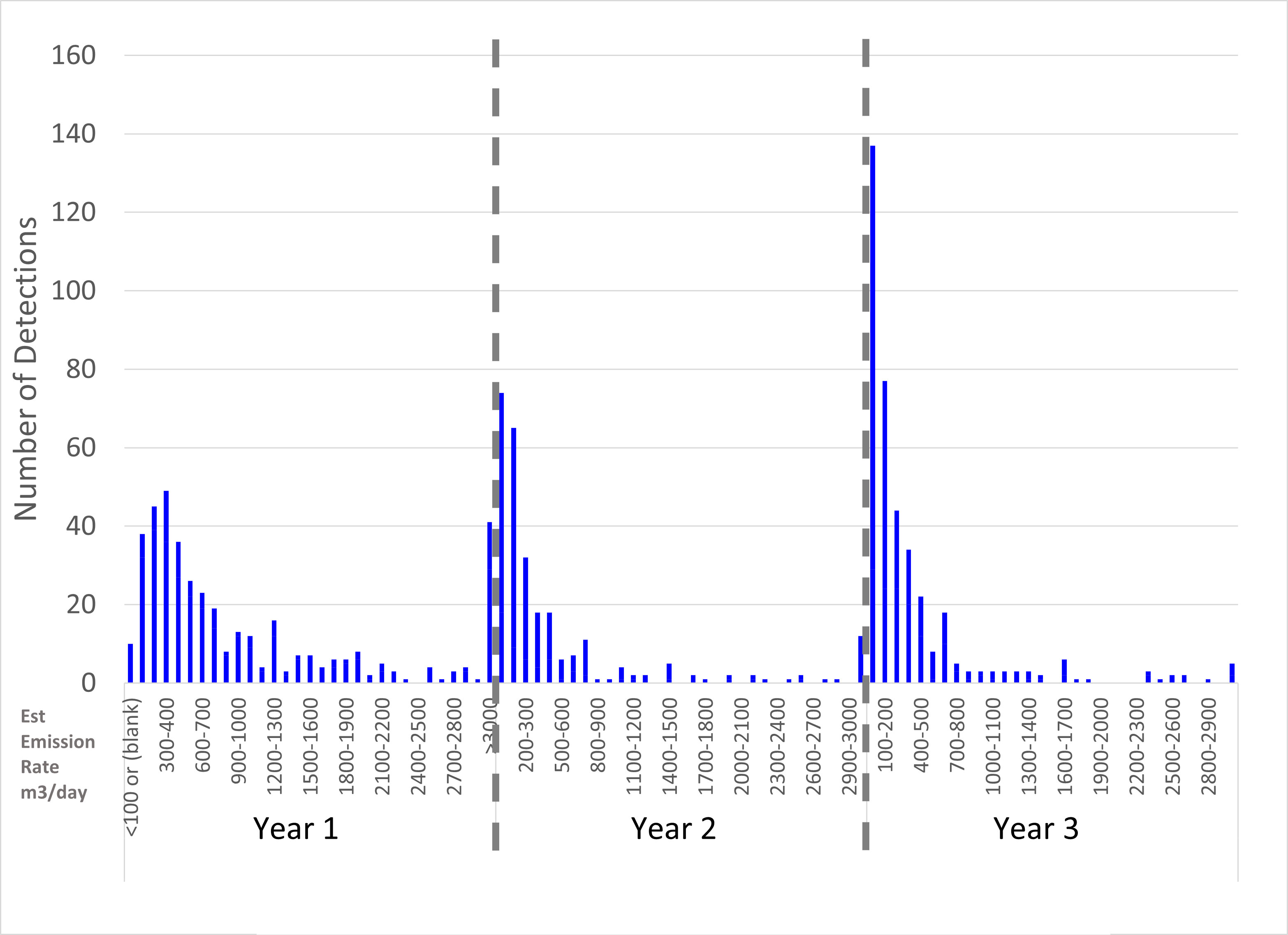Section 8.10.6 of Directive 060: Upstream Petroleum Industry Flaring, Incinerating, and Venting states that we will consider innovative and science-based alternatives to the fugitive emissions management program (FEMP) described in the directive.
Performance Report Submission
Within 60 days of the expiry of the alt-FEMP approval or as part of the renewal process, the operator must submit a final alt-FEMP performance report to the AER. The AER will review the report to determine whether the program was successful and, if not, determine the extent of any required future study. The performance report should include the information outlined below.
Email the performance report and any supporting documentation to @email and identify the company or group name and performance report submission in the email subject line. For example,
[Company name], Alternative FEMP Performance Report
Public Document
Performance reports and the supporting data are intended to be made public and posted on the AER alt-FEMP approvals and performance reports webpage.
Report Content
The following table lists the performance report contents for interim and final reports. Report content may vary depending on the program’s structure.
| Performance report requirements | Interim performance report (submitted annually |
Final performance report (submitted 60 days after approval expiry or as indicated in approval) |
|---|---|---|
| Screening data | Yes, include a summary in the report and detailed data | Yes, include a summary in the report and detailed data |
| Follow-up data | Yes | Yes |
| Emission summary | Yes | Yes |
| Emission reduction summary | Not required (voluntary submission) | Yes |
| Technology limitations | Not required (voluntary submission) | Yes |
| Success of the alt-FEMP | Not required (voluntary submission) | Yes |
| Nonperforming program elements | Yes | Yes |
| Additional control measures | Not required (voluntary submission) | Yes |
| Additional information | Not required (voluntary submission) | Yes |
| Key performance indicators | Not required (voluntary submission) | Yes |
Screening Data
Include all raw data from screening. Do not filter data to include only fugitive emissions.
Mobile monitoring (example 1)
- Report the total emissions for each site by screening campaign. For example, if a site had three emissions (100, 50, and 10 m3/d) during a campaign, report 160 m3/d for that site and campaign.
- Report individual emissions for each site by screening campaign. Based on the preceding example, report each of the three detected emissions.
For each of the above, provide the requested information in a table in an appendix to the report. If the detection technology cannot report individual emissions (i.e., totals only), clearly note this in the report. The table of individual emissions will then be the same as the table of total emissions.
| Year | 2020 | 2021 | 2022 |
|---|---|---|---|
| Number of sites screened | 1,194 | 1,012 | 1,200 |
| Number of sites with detections | 486 | 271 | 387 |
| Number of detections | 865 | 401 | 550 |
| Percentage sites with detections (%) | 40.70 | 26.80 | 32.30 |
| Average emissions per site with detection (m3/d) | 1,168 | 597 | 397 |
| Total volume identified (m3/d) | 567,829 | 161,725 | 153,557 |
| Number of sites followed up | 146 | 81 | 116 |
| Percentage of sites followed up (%) | 12 | 8 | 10 |
| Number of follow-up sites with no detections | 15 | 7 | 7 |
| Number of follow-up emissions with emission source not detected | 20 | 10 | 12 |
| Average time between detection to follow-up to site (d) | 42.5 | 40.1 | 38.7 |
| Percentage of follow-up sites that are recurring (%) | 70 | 73 | 68 |
| Number of emissions from the screenings that were followed up | 125 | 75 | 81 |
| Number of emissions from the screenings that were followed up and identified as fugitive emissions | 42 | 25 | 31 |
| Volume of fugitives identified and fixed for the calendar year (m3) | 53,660 | 12,532 | 9,964 |
Continuous monitoring (example 2)
- Total emissions quantified for the month (m3)
- Site pressurized hours per month (hr)
- Sensor operational hours per month (hr)
- Number of detection events per year per site
- Number of detection events classified as potential fugitive emission sources per site
The alt-FEMP work practice defines a detection event as the threshold for which a follow-up is required.
Site X
| Month | 1 | 2 | 3 | 4 | 5 | 6 | 7 | 8 | 9 | 10 | 11 | 12 |
|---|---|---|---|---|---|---|---|---|---|---|---|---|
| Total emissions quantified in month (m3) | 1,168 | 1,192 | 1,145 | 1,157 | 1,133 | 1,122 | 1,110 | 1,098 | 1,133 | 1,145 | 1,110 | 1,104 |
| Sit pressurized hours per month | 744 | 696 | 744 | 720 | 658 | 720 | 744 | 744 | 720 | 744 | 720 | 744 |
| Sensor operational hours per month | 744 | 696 | 729 | 720 | 744 | 720 | 744 | 698 | 720 | 744 | 720 | 744 |
| Number of detection events per year per site | 1 | 1 | 1 | 2 | 1 | 2 | ||||||
| Number of detection events which were identified as fugitive | 1 | 1 | 1 |
Follow-up Data (use annual data if applicable)
- Number of sites followed up on for the year (see example 1)
- Percentage of sites followed up (see example 1)
- Percentage of sites with detections followed up (see example 1)
- Number of follow-up surveys where no emissions were found (see example 1)
- Average time between detection and follow-up to site (days) (see example 1)
- Issues affecting follow-up times
- Number of follow-ups per year per site (see example 2)
- Percentage of follow-up sites that are recurring (for the calendar year – following up on a site more than once) (see example 1)
- Identified emission source types per follow-up per screening campaign (vent, fugitive, methane slip, other):
- number of detections by emission source type
- volume of detections by emission source type
- Identified emission equipment source types per follow-up per screening campaign (e.g., tank, compressor seal):
- number of detections by equipment type
- volume of detections by equipment type
- Number of recurring leaks observed (if the leak occurred more than once per year)
Emissions Summary
Screening Summary
- Screening site emissions distribution (includes vents, methane slip, fugitives, and others):
- compare to each calendar year if applicable (see example 3)
- Screening detections emissions distribution (includes vents, methane slip, fugitives, and others):
- compare to each calendar year if applicable (see example 3)
- Screening detections emissions distribution of emissions identified as fugitives:
- compare each calendar year if applicable (see example 3)
- Table summarizing screening findings (by year if applicable; see example 1):
- total number of sites screened
- total volume identified (m3/d)
- percentage of sites with detections
- average emissions per site with detection
Survey Summary
- Survey site emissions distribution (includes vents, methane slip, fugitives, and others):
- compare to each calendar year if applicable (see example 3)
- Survey detections emissions distribution (includes vents, methane slip, fugitives, and others):
- compare to each calendar year if applicable (see example 3)
- Survey detections emissions distribution of emissions identified as fugitives:
- compare each calendar year if applicable (see example 3)
- Table summarizing survey findings (separate by identified by screening, control, other):
- total number of sites surveyed
- total volume identified (m3/d)
- percentage of sites with detections
- average emissions per site with detection
Control vs alt-FEMP Summary
- Compare emission findings from the control region versus alt-FEMP (if applicable)
Example 3:

Emission Reduction Summary
- Using a plot showing the log-scale emissions rate assumption against the cumulative distribution frequency, compare the proposal assumed emission distribution versus the as-found emission distribution.
- Overlay the MDL @ 90% PoD of the screening technologies.
- Model the alt-FEMP program using the as-found distribution and compare the results with traditional FEMP methods and frequencies. Do not model or compare with the proposal emission distribution.
Technology Limitation
- Provide information on technology performance during the pilot or full-scale program while deployed in the field. Include details on weather and smoke effects, measurement, detection limit, and any other performance indicator.
Success of the Alt-FEMP
- Detail the success of the alt-FEMP in meeting the objectives of the application.
Nonperforming Program Elements
- Identify any alt-FEMP elements that did not meet expectations.
- Provide details of any changes made to the technology or work practices during the alt-FEMP in response to nonperforming elements or to optimize the program.
Additional Control Measures
- Summarize any additional control measures or plans added to the program or required by the approval.
Additional Information
- Summarize any other performance analysis completed to assess the success of the alt-FEMP.
Key Performance Indicators
- Provide a summary of the key performance indicators included in the application and not reported in any other section.


